Related Research Articles

Fra Angelico, OP was a Dominican friar and Italian painter of the Early Renaissance, described by Giorgio Vasari in his Lives of the Artists as having "a rare and perfect talent". He earned his reputation primarily for the series of frescoes he made for his own friary, San Marco, in Florence, then worked in Rome and other cities. All his known work is of religious subjects.

Alessandro Bonvicino, more commonly known as Moretto, or in Italian Il Moretto da Brescia, was an Italian Renaissance painter from Brescia, where he also mostly worked. His dated works span the period from 1524 to 1554, but he was already described as a master in 1516. He was mainly a painter of altarpieces that tend towards sedateness, mostly for churches in and around Brescia, but also in Bergamo, Milan, Verona, and Asola; many remain in the churches they were painted for. The majority of these are on canvas, but a considerable number, including some large pieces, are created on wood panels. There are only a few surviving drawings from the artist.

Antonio Balestra was an Italian painter of the Rococo period.

Giuseppe Bartolomeo Chiari, also known simply as Giuseppe Chiari, was an Italian painter of the late-Baroque period, active mostly in Rome.
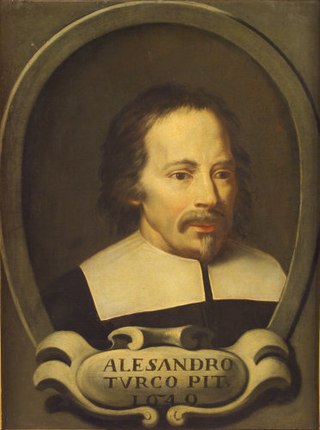
Alessandro Turchi was an Italian painter of the early Baroque, born and active mainly in Verona, and moving late in life to Rome. He also went by the name Alessandro Veronese or the nickname L'Orbetto. His style has been described as soft and Caravaggesque at the same time.
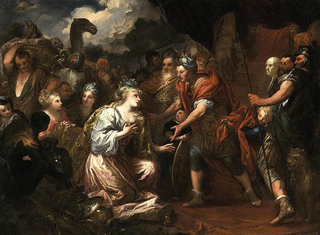
Pietro Dandini was an Italian painter of the Baroque period, active mainly in Florence.

Giovanni Giacomo Barbelli was an Italian painter of the Baroque period, active in Lombardy. He was a canvas and fresco painter known for his religious and mythological scenes that decorate many churches and residences in Lombardy. He was a highly skilled draughtsman and a brilliant colorist. His work shows an inventive imagination and a thorough knowledge of perspective.

Antonio Randa was an Italian painter of the classicist period, active in Ferrara, Modena, Rovigo, Florence, Comacchio and his native Bologna.

Antonio Triva was an Italian painter and engraver of the Baroque period.

Guglielmo de Sanctis was an Italian painter.
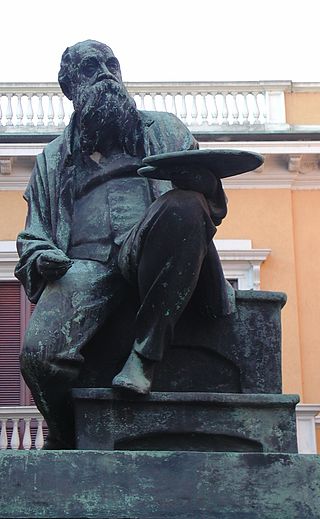
Mosè Bianchi (1840–1904) was an Italian painter and printmaker.

Francesco Podesti was an Italian painter, active in a Romantic style. Together with Francesco Hayez and Giuseppe Bezzuoli, he is considered one of the greatest Italian painters of the first half of the 19th century. He was prolific in his large canvases on historical subjects. He is best known for his fresco work, including those in the Hall of the Immacolata in the Vatican Museum.
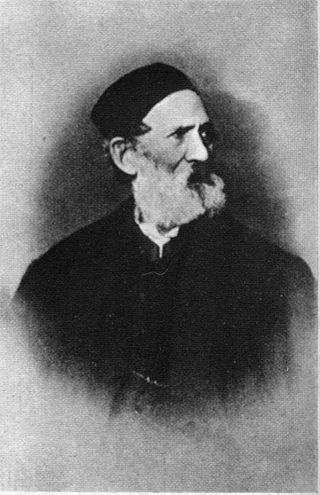
Adeodato Malatesta was an Italian painter, trained in a grand Neoclassical style, depicting mostly of sacred and historic subjects.

Teofilo Patini was an Italian painter, active in a Realist style.

The Monastery and Church of San Pietro is a building complex located on Via San Pietro in central Modena, Italy. The site still hosts an active Benedictine monastery, and the building now serves as a parish church.
Giovanni Ghirlandini was an Italian painter, mainly depicting sacred subjects.
Vincenzo De Mita was an Italian painter, mainly depicting sacred subjects.
Antonio Simonazzi was an Italian painter, active mainly in his native Modena.
Paolo Gamba was an Italian painter of the late Baroque period, active in the region of Molise.
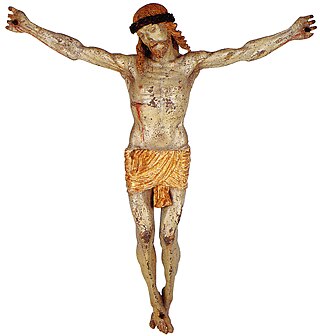
Maffeo Olivieri was an Italian sculptor and wood carver. Often associated with his younger brother Andrea, he was active in Lombardy, Venice and Trentino. He was known for his bronze, wood and marble creations, and considered the premier sculptor in early sixteenth century Brescia.
References
- ↑ Istituto Matteucci, short biography.
- ↑ A regola d'arte: monumenti future: pittori, scultori, architetti, fotografi, scenografi, ceramisti, galleristi, critici, e storici d'arte nel Modenese dell'ottocento e del novecento, by Alberto Barbieri, Muchi editore (2008): page 320.